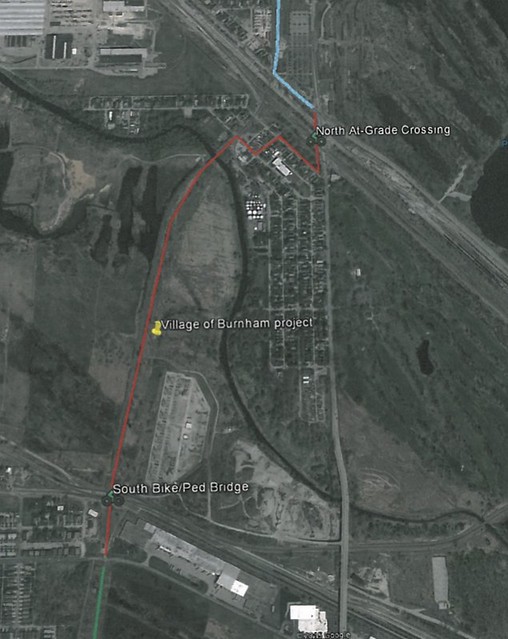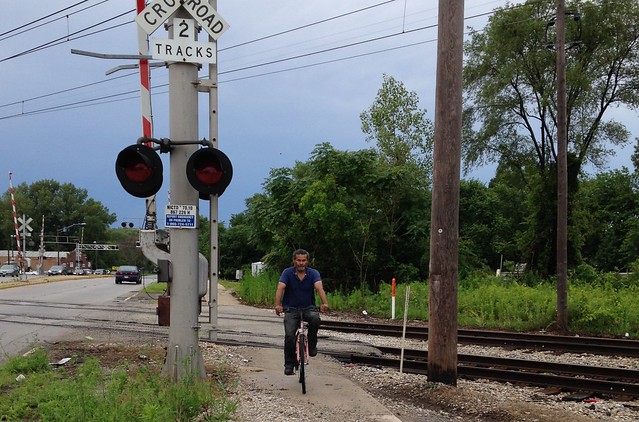Last August, the board of the Northern Indiana Commuter Transit District did the right thing by voting to dramatically reduce the wait until customers are allowed to bring bikes on South Shore Line trains. While NICTD had previously been talking about delaying the bikes-on-board pilot until 2021, they instead agreed to test the program this April. Their decision was surely influenced by the Active Transportation Alliance sarcastically giving them the Broken Spoke Award as “the least bike-friendly commuter rail service in the nation.”
But there’s another important bike issue that NICTD is still dragging their feet about. The 11-mile Burnham Greenway Trail will eventually connect Chicago’s Lakefront Trail with the growing network of multiuse paths in the south suburbs and Northwest Indiana, including the Cal-Sag Trail. However, there’s a two-mile gap in the trail in the city’s Hegewisch neighborhood and the suburb of Burnham.
The gap forces cyclists to ride on wide roads with fast traffic, or else detour several miles out of the way. Although the needed two-mile stretch of trail is already designed, approved, and funded, the transit agency doesn’t want to let the trail cross its tracks at grade level. Instead, NICTD, along with the South Shore Freight Line, is insisting that a multimillion-dollar bridge be built, a project that would take years to complete.
The trail crossing in question would be on Burnham Avenue just south of Brainerd Avenue, near the South Shore’s Hegewisch station. “NICTD is worried about safety and liability,” explains Active Trans suburban outreach coordinator Leslie Phemister. “But right now there’s nothing to stop a pedestrian from walking onto the tracks when a train is coming.” There are currently crossing gates and warning signals for drivers, but not for pedestrians.
The planned trail crossing would involve widening the existing sidewalk to accommodate bikes, adding bollards to keep pedestrians and cyclists out of the street, and adding gates that would block the sidewalk when a train approaches. Phemister says the transit agency should welcome these improvements, which would benefit people walking to the station. “Safety is everyone’s concern,” she says. “No one wants to get hit by a train.”

Instead, NICTD is pushing for the bridge, which Phemister says would take $8 million and eight years to complete. “And pedestrians tend to not want to use bridges when there’s already an at-grade crossing,” she says. Since the South Shore trains have overhead electrical wires, the bridge would have to be very high to clear them. And because the access ramps would have to have a wheelchair-friendly slope, the bridge would be a significant detour for people on foot.
Chicago and the village of Burnham plan (where the crossing is located) plan to build their respective sections of the path this year. Meanwhile, the Illinois Commerce Commission has been pushing the village and the transit agency to reach an agreement about the crossing. The deadline has been pushed back six times since March 2015, and another meeting is scheduled for this month, but NICTD is still digging in their heels.
“If it winds up going to trial, NICTD and Burnham will have to bring in witnesses, and each side could spend more than $50,000 in legal fees,” Phemister said. “That represents a lot of money from Illinois and Indiana taxpayers.”
Moreover, the transit agency’s insistence on a grade-separated crossing sets a bad precedent for future projects. NICTD is looking into building a new spur of the South Shore Line that would head south to serve Munster and Dyer, Indiana. “If they want a pedestrian bridge at every single one of the at-grade crossings along the route, that would be a big expense for taxpayers,” Phemister said.
So far, 345 people have signed an Active Trans petition urging the transit agency to sign off on the at-grade crossing. “I’m a positive person,” says Phemister. “I like to think that NICTD will see the light on this issue.”
The spokesman for the transit agency did not respond to my request for an interview.
This post is made possible by a grant from the Illinois Bicycle Lawyers at Keating Law Offices, P.C., a Chicago, Illinois law firm committed to representing pedestrians and cyclists. The content is Streetsblog Chicago's own, and Keating Law Offices neither endorses the content nor exercises any editorial control.






